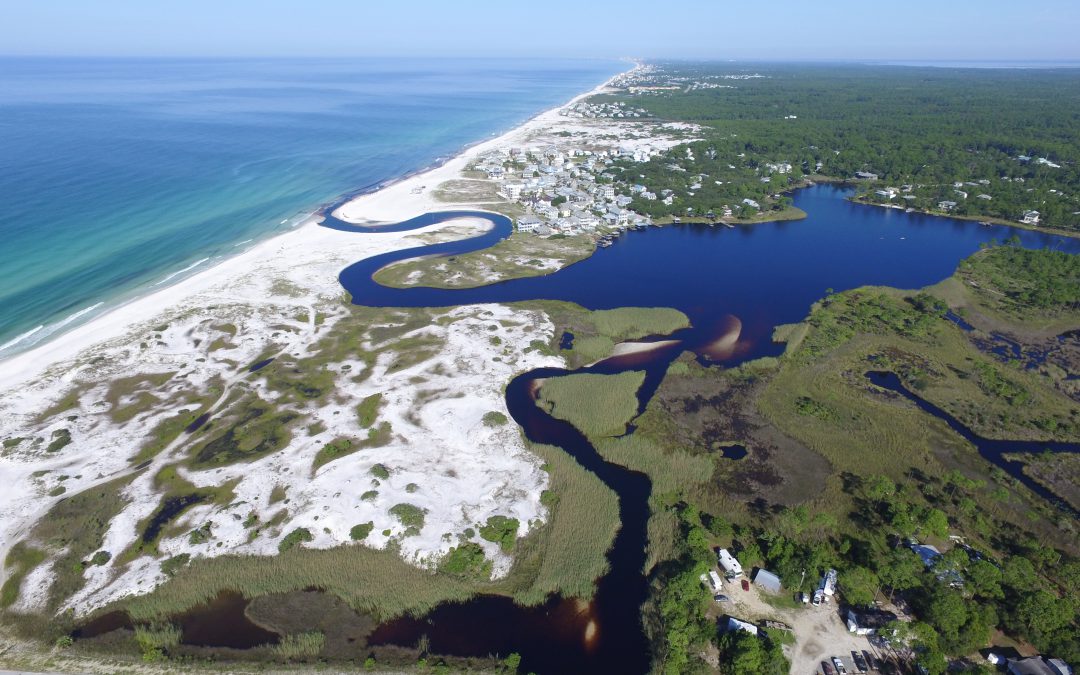
by Sheila Dunning | Sep 29, 2022
October has been designated as Coastal Dune Lake Appreciation month by Walton County government. Walton County is home to 15 named coastal dune lakes along 26 miles of coastline. These lakes are a unique geographical feature and are only found in a few places in the world including Madagascar, Australia, New Zealand, Oregon, and here in Walton County.
A coastal dune lake is defined as a shallow, irregularly shaped or elliptic depressions occurring in coastal communities that share an intermittent connection with the Gulf of Mexico through which freshwater and saltwater is exchanged. They are generally permanent water bodies, although water levels may fluctuate substantially. Typically identified as lentic water bodies without significant surface inflows or outflows, the water in a dune lake is largely derived from lateral ground water seepage through the surrounding well-drained coastal sands. Storms occasionally provide large inputs of salt water and salinities vary dramatically over the long term.
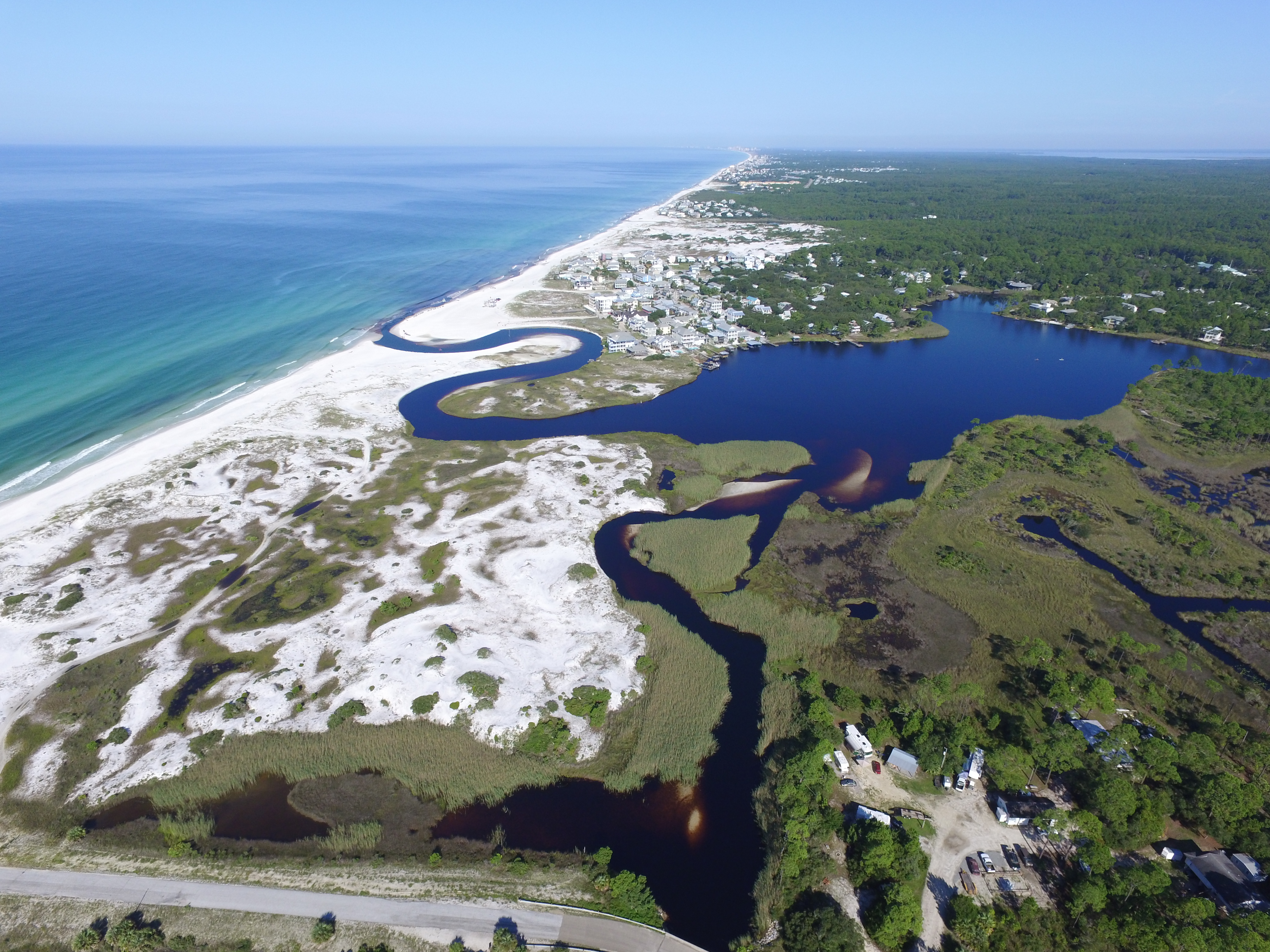 Our coastal dune lakes are even more unique because they share an intermittent connection with the Gulf of Mexico, referred to as an “outfall”, which aides in natural flood control allowing the lake water to pour into the Gulf as needed. The lake water is fed by streams, groundwater seepage, rain, and storm surge. Each individual lake’s outfall and chemistry is different. Water conditions between lakes can vary greatly, from completely fresh to significantly saline.
Our coastal dune lakes are even more unique because they share an intermittent connection with the Gulf of Mexico, referred to as an “outfall”, which aides in natural flood control allowing the lake water to pour into the Gulf as needed. The lake water is fed by streams, groundwater seepage, rain, and storm surge. Each individual lake’s outfall and chemistry is different. Water conditions between lakes can vary greatly, from completely fresh to significantly saline.
A variety of different plant and animal species can be found among the lakes. Both freshwater and saltwater species can exist in this unique habitat. Some of the plant species include: rushes (Juncus spp.), sedges (Cyperus spp.), marshpennywort (Hydrocotyle umbellata), cattails (Typha spp.), sawgrass (Cladium jamaicense), waterlilies (Nymphaea spp.), watershield (Brasenia schreberi), royal fern (Osmunda regalis var. spectabilis), rosy camphorweed (Pluchea spp.), marshelder (Iva frutescens), groundsel tree (Baccharis halimifolia), and black willow (Salix nigra).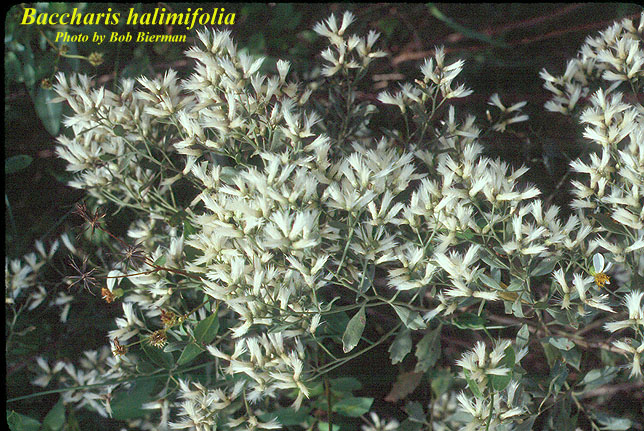
Some of the animal species that can be found include: western mosquitofish (Gambusia affinis), sailfin molly (Poecilia latipinna), American alligator (Alligator mississippiensis), eastern mud turtle (Kinosternon subrubrum), saltmarsh snake (Nerodia clarkii ssp.), little blue heron (Egretta caerulea), American coot (Fulica americana), and North American river otter (Lutra canadensis). Many marine species co-exist with freshwater species due to the change in salinity within the column of water.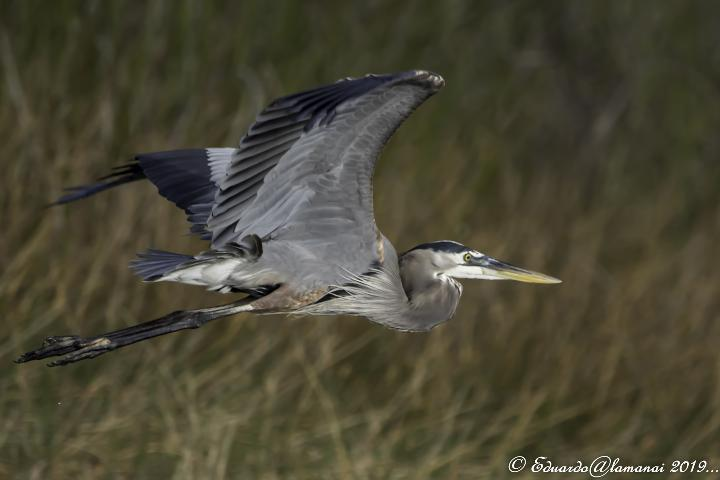
The University of Florida/IFAS Extension faculty are reintroducing their acclaimed “Panhandle Outdoors LIVE!” series. Come celebrate Coastal Dune Lake Appreciation month as our team provides a guided walking tour of the nature trail surrounding Western Lake in Grayton Beach State Park. Join local County Extension Agents to learn more about our globally rare coastal dune lakes, their history, surrounding ecosystems, and local protections. Walk the nature trail through coastal habitats including maritime hammocks, coastal scrub, salt marsh wetlands, and coastal forest. A tour is available October 19th.
The tour is $10.00 (plus tax) and you can register on Eventbrite (see link below). Admission into the park is an additional $5.00 per vehicle, so carpooling is encouraged. We will meet at the beach pavilion (restroom facilities available) at 8:45 am with a lecture and tour start time of 9:00 am sharp. The nature trail is approximately one mile long, through some sandy dunes (can be challenging to walk in), on hard-packed trails, and sometimes soggy forests. Wear appropriate footwear and bring water. Hat, sunscreen, camera, binoculars are optional. Tour is approximately 2 hours. Tour may be cancelled in the event of bad weather.
Register here on Eventbrite: https://www.eventbrite.com/e/panhandle-outdoor-live-coastal-dune-lake-lecture-and-nature-trail-tour-tickets-419061633627
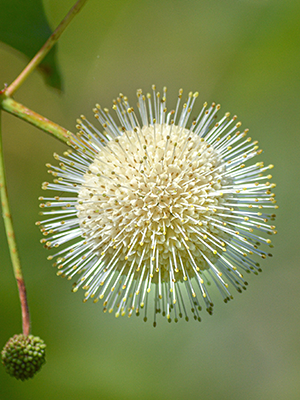
by Sheila Dunning | Jun 23, 2022
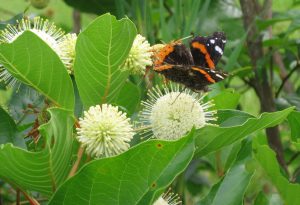 Beginning in 2007 the US Senate, in support of the North American Pollinator Protection Campaign, declared the last week of June as “National Pollinator Week.” As humans, we depend on pollen-moving animals for one out of every three bites of food. Without birds, bees, bats, beetles, butterflies, and various other animals, many flowers would fail to reproduce. In Florida there are numerous native plants that serve as hosts for these pollinators.
Beginning in 2007 the US Senate, in support of the North American Pollinator Protection Campaign, declared the last week of June as “National Pollinator Week.” As humans, we depend on pollen-moving animals for one out of every three bites of food. Without birds, bees, bats, beetles, butterflies, and various other animals, many flowers would fail to reproduce. In Florida there are numerous native plants that serve as hosts for these pollinators.
One of the favorites, due to its heavy flowering over the summer, is Buttonbush (Cephalanthus occidentalis). 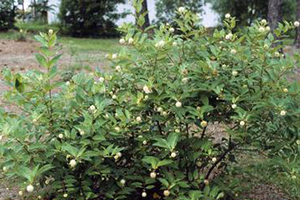 It is a semi-aquatic woody shrub to small tree that develops white golf-ball-sized clusters of fragrant flowers, attracting various pollinating animals. Bees of various species, several different wasps, assorted moths and butterflies, flies and even hummingbirds scramble for the flowers’ sweet treat within each of the trumpet shaped flowers. The pincushion-like flower balls stand on two inch stalks in clusters arising from stem tips and leaf axils. They are produced over a long period in late spring and summer. The flowers give way to little reddish-brown nutlets which persist on the through the winter. Buttonbush seeds are important wildlife food, especially for ducks; and the dense, impenetrable tickets provide nesting and escape cover for many wetland birds and herptiles. Buttonbush is a fast-growing wetland plant that can be grown in a naturalized landscape if given supplemental water during dry spells. It is at its best, through, in an area where the soil is frequently wet and can tolerate soggy soils. Buttonbush is not drought or salt tolerant. The deciduous shrub grows well in full sun to partial shade on soils that are acidic to slightly alkaline. The leaves of Buttonbush turn yellow in the fall before dropping off. While short-lived, requiring rejuvenation pruning to improve its longevity, Buttonbush (Cephalanthus occidentalis) serves a critical role to wildlife in the wetland habitat. Deer browse the foliage and twigs. Ducks, especially the mallard, eat the seeds. And, the summer flowers attract bees, butterflies and moths; our wonderful pollinators.
It is a semi-aquatic woody shrub to small tree that develops white golf-ball-sized clusters of fragrant flowers, attracting various pollinating animals. Bees of various species, several different wasps, assorted moths and butterflies, flies and even hummingbirds scramble for the flowers’ sweet treat within each of the trumpet shaped flowers. The pincushion-like flower balls stand on two inch stalks in clusters arising from stem tips and leaf axils. They are produced over a long period in late spring and summer. The flowers give way to little reddish-brown nutlets which persist on the through the winter. Buttonbush seeds are important wildlife food, especially for ducks; and the dense, impenetrable tickets provide nesting and escape cover for many wetland birds and herptiles. Buttonbush is a fast-growing wetland plant that can be grown in a naturalized landscape if given supplemental water during dry spells. It is at its best, through, in an area where the soil is frequently wet and can tolerate soggy soils. Buttonbush is not drought or salt tolerant. The deciduous shrub grows well in full sun to partial shade on soils that are acidic to slightly alkaline. The leaves of Buttonbush turn yellow in the fall before dropping off. While short-lived, requiring rejuvenation pruning to improve its longevity, Buttonbush (Cephalanthus occidentalis) serves a critical role to wildlife in the wetland habitat. Deer browse the foliage and twigs. Ducks, especially the mallard, eat the seeds. And, the summer flowers attract bees, butterflies and moths; our wonderful pollinators.

by Sheila Dunning | Jan 6, 2022
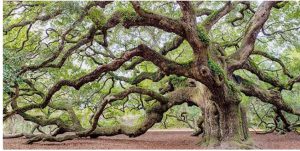
Old Live Oak
Picture from National Wildlife Foundation
The best time to plant a tree is twenty years ago. The second best time is Arbor Day. Florida recognizes the event on the third Friday in January, but planting any time before spring will establish a tree quickly.
Arbor Day is an annual observance that celebrates the role of trees in our lives and promotes tree planting and care. As a formal holiday, it was first observed on April 10, 1872 in the state of Nebraska. Today, every state and many countries join in the recognition of trees impact on people and the environment.
Trees are the longest living organisms on the planet and one of the earth’s greatest natural resources. They keep our air supply clean, reduce noise pollution, improve water quality, help prevent erosion, provide food and building materials, create shade, and help make our landscapes look beautiful. A single tree produces approximately 260 pounds of oxygen per year. That means two mature trees can supply enough oxygen annually to support a family of four.
The idea for Arbor Day in the U.S. began with Julius Sterling Morton. In 1854 he moved from Detroit to the area that is now the state of Nebraska. J. Sterling Morton was a journalist and nature lover who noticed that there were virtually no trees in Nebraska. He wrote and spoke about environmental stewardship and encouraged everyone to plant trees. Morton emphasized that trees were needed to act as windbreaks, to stabilize the soil, to provide shade, as well as fuel and building materials for the early pioneers to prosper in the developing state.
In 1872, The State Board of Agriculture accepted a resolution by J. Sterling Morton “to set aside one day to plant trees, both forest and fruit.” On April 10, 1872 one million trees were planted in Nebraska in honor of the first Arbor Day. Shortly after the 1872 observance, several other states passed legislation to observe Arbor Day. By 1920, 45 states and territories celebrated Arbor Day. Richard Nixon proclaimed the last Friday in April as National Arbor Day during his presidency in 1970.
Today, all 50 states in the U.S. have official Arbor Day, usually at a time of year that has the correct climatological conditions for planting trees. For Florida, the ideal tree planting time is January, so Florida’s Arbor Day is celebrated on the third Friday of the month. Similar events are observed throughout the world. In Israel it is the Tu B Shevat (New Year for Trees). Germany has Tag des Baumes. Japan and Korea celebrate an entire week in April. Even Iceland, one of the most treeless countries in the world observes Student’s Afforestation Day.
The trees planted on Arbor Day show a concern for future generations. The simple act of planting a tree represents a belief that the tree will grow and someday provide wood products, wildlife habitat, erosion control, shelter from wind and sun, beauty, and inspiration for ourselves and our children.
“It is well that you should celebrate your Arbor Day thoughtfully, for within your lifetime the nation’s need of trees will become serious. We of an older generation can get along with what we have, though with growing hardship; but in your full manhood and womanhood you will want what nature once so bountifully supplied and man so thoughtlessly destroyed; and because of that want you will reproach us, not for what we have used, but for what we have wasted.”
~Theodore Roosevelt, 1907 Arbor Day Message
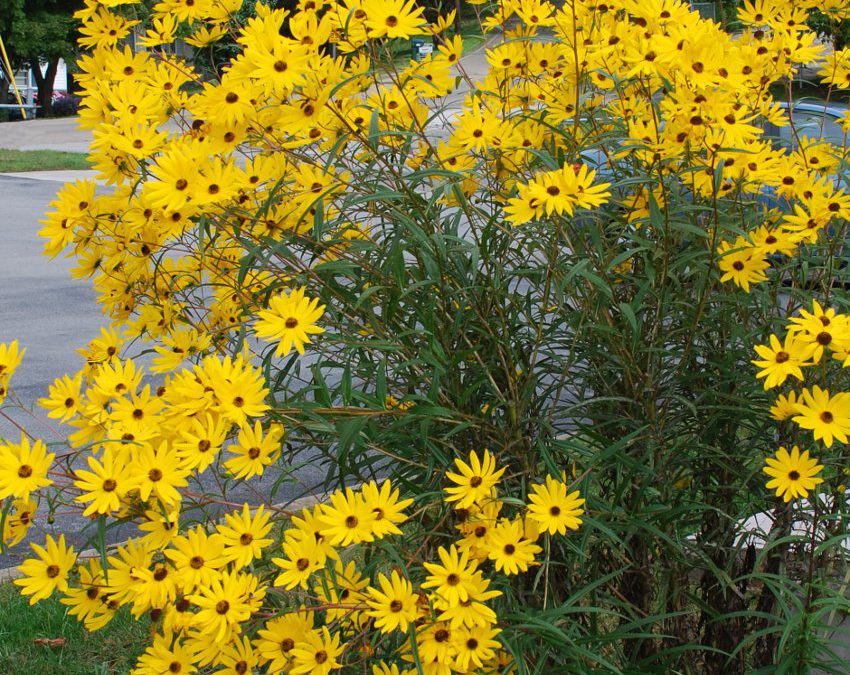
by Sheila Dunning | Oct 7, 2021
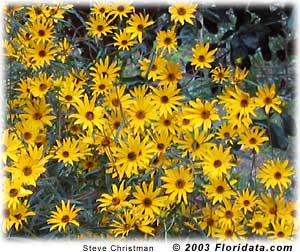
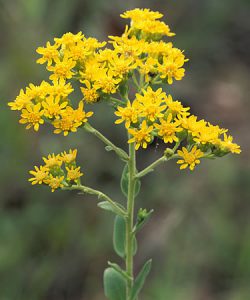
Goldenrod
Each fall, nature puts on a brilliant show of color throughout the United States. As the temperatures drop, autumn encourages the “leaf peepers” to hit the road in search of the red-, yellow- and orange-colored leaves of the northern deciduous trees. Here in the Florida Panhandle, fall color means wildflowers. As one drives the roads it’s nearly impossible to not see the bright yellows in the ditches and along the wood’s edge. Golden Asters (Chrysopsis spp.), Tickseeds (Coreopsis spp.), Silkgrasses (Pityopsis spp.), Sunflowers (Helianthus spp.) and Goldenrods (Solidago spp.) are displaying their petals of gold at every turn. These wildflowers are all members of the Aster family, one of the largest plant families in the world. For most, envisioning an Aster means a flower that looks like a daisy. While many are daisy-like in structure, others lack the petals and appear more like cascading sprays. So, if you are one of the many “hitting the road in search of fall color”, head to open areas. For wildflowers, that means rural locations with limited homes and businesses. Forested areas and non-grazed pastures typically have showy displays, especially when a spring burn was performed earlier in the year. With the drought we experienced, moist, low-lying areas will naturally be the best areas to view the many golden wildflowers. Visit the Florida Wildflower Foundation website, www.flawildflowers.org/bloom.php, to see both what’s in bloom and the locations of the state’s prime viewing areas.
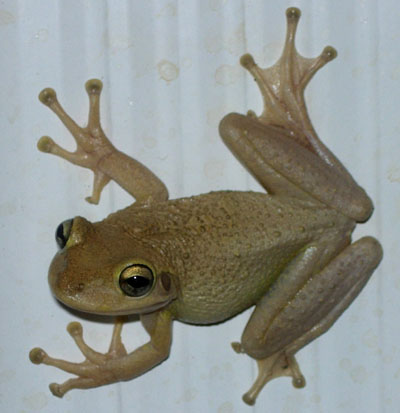
by Sheila Dunning | Jul 15, 2021
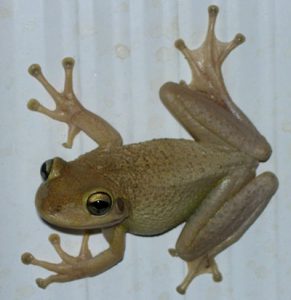
Photo by: Dr. Steve Johnson
Treefrog calls are often heard with each rain event. But, how about a “snoring raspy” call that begins after a day time light rain? That may be a male Cuban treefrog trying to attract the girls. Cuban treefrogs breed predominately in the spring and summer. Reproduction is largely stimulated by rainfall, especially warm summer rains such as those associated with tropical weather systems and intense thunderstorms.
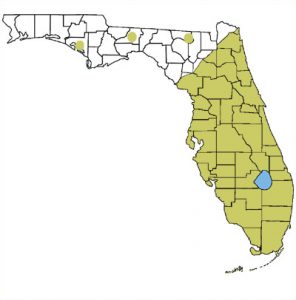
Range of Cuban treefrog
The Cuban treefrog, Osteopilus septentrionalis, was accidently introduced to Florida in the 1920’s as a stowaway in shipping crates from the Caribbean. Over the last hundred years, the invasive frog has managed to spread throughout Florida and the Southeastern U.S. by hitchhiking on ornamental plants, motorized vehicles and boats. Though occasional cold winters have created temporary population setbacks, new generations of Cuban treefrogs continue to be reported in north Florida, including the Panhandle.
An invasive species is generally defined as a plant, animal or microbe that is found outside od its native range, where it negatively impacts the ecology, economy or quality of human life. Cuban treefrogs come out at night to feed on snails, millipedes, spiders and a vast array of insects. But, they are also predators of several Florida native frogs, lizards and snakes. Tadpoles of the invasive Cuban treefrog have been shown to inhibit the growth and development of native Southern toad and green treefrog tadpoles when all of the species are in the same water body. Additionally, a large female Cuban treefrog can lay over 10,000 eggs per season in very small amounts of water.
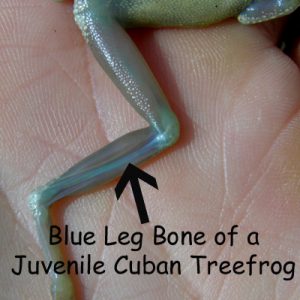 Panhandle citizens can help manage the invasive Cuban treefrog by learning to identify them and reduce their numbers. All treefrogs have expanded pads on the ends of their toes. Cuban treefrogs have exceptionally large toepads. They also have a “big eyed” appearance due to their oversized bulging eyes. Cuban treefrogs may exceed 6 inches in length, have warty-looking skin with possible blotches, bands or stripes, and vary greatly in color. However, they can be distinguished from other treefrogs. Cuban treefrogs have a yellowish wash where their front and rear legs are attached to their body. Juvenile Cuban treefrogs have red eyes and blue bones visible through the skin of their hind legs. The skin of the Cuban treefrog produces a sticky secretion that can cause a burning or itching sensation if it contacts the eyes or nose of certain individuals. It is recommended to wear gloves and wash your hands after handling Cuban treefrogs.
Panhandle citizens can help manage the invasive Cuban treefrog by learning to identify them and reduce their numbers. All treefrogs have expanded pads on the ends of their toes. Cuban treefrogs have exceptionally large toepads. They also have a “big eyed” appearance due to their oversized bulging eyes. Cuban treefrogs may exceed 6 inches in length, have warty-looking skin with possible blotches, bands or stripes, and vary greatly in color. However, they can be distinguished from other treefrogs. Cuban treefrogs have a yellowish wash where their front and rear legs are attached to their body. Juvenile Cuban treefrogs have red eyes and blue bones visible through the skin of their hind legs. The skin of the Cuban treefrog produces a sticky secretion that can cause a burning or itching sensation if it contacts the eyes or nose of certain individuals. It is recommended to wear gloves and wash your hands after handling Cuban treefrogs.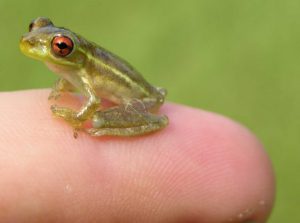
It is important to document the locations of Cuban treefrogs in the Panhandle. By placing short sections of PVC pipe in the ground around your home and garden will provide hiding places for treefrogs that enables you to monitor for Cuban treefrogs. Cut 10 foot sections of 1.5-inch-diameter PVC pipe into approximately three-foot-long sections and push them into the ground about 3-4 inches. To remove a frog from a pipe, place a clear sandwich bag over the top end, pull the pipe from the ground, and insert a dowel rod in the other end to scare the frog into the baggie. If you suspect you have seen one, take a picture and send it to Dr. Steve Johnson at tadpole@ufl.edu. Include your name, date, and location. Dr. Johnson can verify the identity. If it is a Cuban treefrog, upload the information by going to http://www.eddmaps.org/ and click the “Report Sightings” tab.
Once identified as a Cuban treefrog, it should be euthanized humanly. To do that, the Cuban treefrog in a plastic sandwich bag can be placed into the refrigerator for 3-4 hours then transferred to the freezer for an additional 24 hours. Alternatively, a 1-inch stripe benzocaine-containing ointment (like Orajel) to the frog’s back to chemically anesthetize it before placing it into a freezer. After freezing, remove the bagged frog from the freezer and dispose of in the trash. Ornamental ponds should also be monitored for Cuban treefrog egg masses especially after a heavy rain. The morning after a rain, use a small-mesh aquarium net to scoop out masses of eggs floating on the surface of the pond and simply discard them on the ground to dry out. Various objects that can collect water found throughout your yard need to be dumped out regularly to reduce breeding spots for both Cuban treefrogs and mosquitoes.

 Our coastal dune lakes are even more unique because they share an intermittent connection with the Gulf of Mexico, referred to as an “outfall”, which aides in natural flood control allowing the lake water to pour into the Gulf as needed. The lake water is fed by streams, groundwater seepage, rain, and storm surge. Each individual lake’s outfall and chemistry is different. Water conditions between lakes can vary greatly, from completely fresh to significantly saline.
Our coastal dune lakes are even more unique because they share an intermittent connection with the Gulf of Mexico, referred to as an “outfall”, which aides in natural flood control allowing the lake water to pour into the Gulf as needed. The lake water is fed by streams, groundwater seepage, rain, and storm surge. Each individual lake’s outfall and chemistry is different. Water conditions between lakes can vary greatly, from completely fresh to significantly saline.














